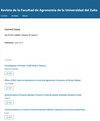不同毒理类群杀菌剂体外中毒对烟草尖孢镰刀菌生长的抑制作用
IF 0.5
4区 农林科学
Q4 AGRONOMY
Revista De La Facultad De Agronomia De La Universidad Del Zulia
Pub Date : 2022-08-25
DOI:10.47280/revfacagron(luz).v39.n3.10
引用次数: 1
摘要
烟草枯萎病(Fusarium oxysporum f. sps . nicotianae)是烟草栽培中最重要的真菌病害之一,也是最难防治的病害之一。评价两种中毒方法的体外有效性;采用敏感圆盘法(SD)和培养基稀释法(DMC)测定了4种不同毒理类群的杀菌剂对古巴Granma省不同地区烟草中分离的尖孢镰刀菌的抑菌效果。在所有测试菌株的敏感性水平上观察到不同的反应,无论中毒方法如何。DMC法比SD法更有效,相对于SD从4.37% (S)增加到45.57% (Ip+Pr)。DMC对代铁锌(100%)、Tz+Az(79.74%)和Ip+Pr(96.9%)的抑制值最高。用SD法对产孢抑制效果最好的是代森锰锌(0%)。所评估的杀菌剂(单独或联合使用)的体外抑制效果表明了对所研究真菌的杀真菌效果,并确定了抑制方法对研究杀菌剂在古巴和世界其他地区烟草种植区镰刀菌引起的疾病管理方案中使用的重要性。本文章由计算机程序翻译,如有差异,请以英文原文为准。
Growth inhibition of Fusarium oxysporum f. sp. nicotianae by two in vitro poisoning methods with fungicides of different toxicological groups
Wilt caused by Fusarium oxysporum f. sp. nicotianae is one of the most important fungal diseases in tobacco cultivation, being also one of the most difficult to control. The in vitro effectiveness of two poisoning methods was evaluated; sensi-disc (SD) and medium dilution (DMC) to determine the inhibitory effect of four fungicides of different toxicological groups on F. oxysporum isolated from tobacco in different regions of the province of Granma, Cuba. A differential response was observed in the susceptibility levels of all strains tested, regardless of the method of poisoning. The DMC method was more efficient than the SD, observing increases from 4.37 % (S) to 45.57 % (Ip+Pr) with respect to the SD. The highest inhibition values were observed in DMC with mancozeb (100 %), Tz+Az (79.74 %), and Ip+Pr (96.9 %). The greatest effectiveness in sporulation inhibition was with mancozeb by the SD method (0 %). The in vitro inhibitory effect of the fungicides evaluated (alone or in combination) is indicative of the fungicidal effect on the fungus under study and establishes the importance of inhibition methods for the study of fungicides used in management programs of diseases caused by Fusarium spp., in the tobacco growing areas of Cuba and other parts of the world.
求助全文
通过发布文献求助,成功后即可免费获取论文全文。
去求助
来源期刊
CiteScore
0.50
自引率
0.00%
发文量
45
审稿时长
>12 weeks
期刊介绍:
La Revista de la Facultad de Agronomía de la Universidad del Zulia publica artículos científicos, notas técnicas, comunicaciones rápidas y artículos invitados originales e inéditos, es decir, que no hayan sido publicados ni enviados simultáneamente a otra revista para su publicación, de autores interesados en el campo agrícola vegetal y agrícola animal. De presentarse el caso que el autor o autores hubiesen enviado o publicado su manuscrito simultáneamente en otra revista, podrán ser sancionados con la no publicación en esta revista por tiempo indefinido.
Se admiten manuscritos escritos en idioma Español, Portugués o Inglés, con un resumen en Español o Portugués y otro en Inglés (Abstract).

 求助内容:
求助内容: 应助结果提醒方式:
应助结果提醒方式:


